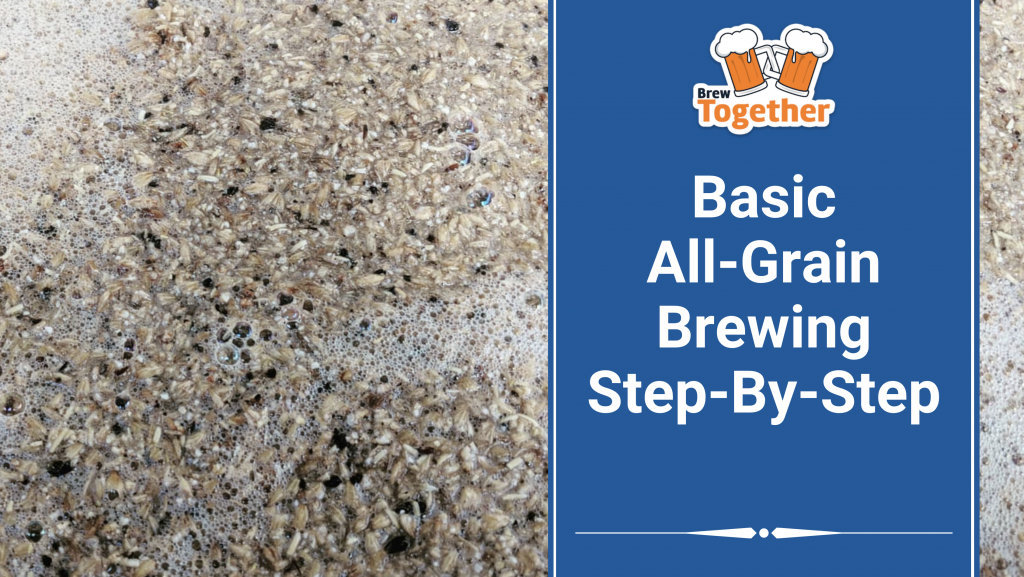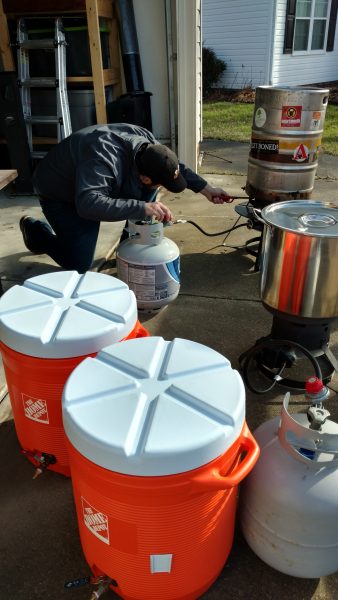Easy Step-By-Step All-Grain Brewing Instructions for Beginners


These are basic instructions covering the main steps of all-grain brewing that were generously provided by BrewTogether user @dave!
Extract brewing, which is how most homebrewers get started, can be likened to baking a cake from a cake mix. You begin with an extract that has been created for you where the grains have already been steeped in hot water to extract the sugars and then boiled down into a thick syrup. You dissolve this thick syrup in hot water and boil it along with hop additions to create your wort
All-grain brewing, which is how breweries make beer, is like baking a cake from scratch. You begin with malted barley and other grain products that you steep in hot water at specific temperatures (mashing) and then rinse (sparging) to extract the sugars. You then boil this liquid along with hop additions to make your wort.
So which method is better? Well, as with baking, a delicious cake can be made from a box mix or from scratch. Likewise, good beer can be brewed by either method. Extract brewing is definitely faster and easier, requires less equipment, and is how most homebrewers start out. All-grain brewing is more time-consuming and requires additional equipment, but allows you more control over both the ingredients and the brewing process. The important thing with either method is to produce a beer that you like and enjoy making it.
As you gain knowledge and experience and as you talk with other brewers, you may develop other techniques and procedures. The important things are to:
- Use fresh, quality ingredients
- Keep all of your equipment clean and sanitized
- Take good notes during the brewing process that you can refer back to later
- Have fun! If you get stressed, just remember to “Relax. Don’t Worry. Have a Homebrew”!
Pre-Brewing Calculations and Water Treatment
- Mash In: ____ lbs grain x .31 gal/lb = _____ gallons at _____° (based on grain temp and target mash temp )
- Mash Out: ____ lbs grain x .155 gal/lb = _____ gallons at _____° (to get to 170°)
- Sparge water: _____ lbs grain x .28 gal/lb = ____ gallons at 168°
- Total water needed: _____. The night before, treat all water with Campden tablets at the rate of ¼ tablet per 5 gallons to remove chlorine and chloramines. Other salts or mineral scan also be added now if desired.
Don’t want to do the math? Click here to use our free Mash and Sparge Water Calculators!
Mashing


- Put calculated volume of strike water for mash-in into brew kettle and heat to target temperature above.
- Pour strike water into mash tun (you may want to pre-warm the mash tun with additional hot water if it is cold).
- Stir in the pre-milled grains, check temperature (target usually 152-153°) and close mash tun for 60 minutes.
- Have a beer!
- While you are waiting, heat the combined volume of sparge water and mash-out water to target temperature for sparge water.
- Pour calculated volume of sparge water into hot liquor tank (HLT) and cover (you may want to pre-warm the HLT with additional hot water if it is cold).
- Heat remaining water in kettle to mash-out temperature.
- After 60 minutes of mashing, add mash-out water, check temp, and close mash tun for 10 more minutes.
Vorlaufing
- After mash-out is completed, take a pitcher, put it under your spigot and open it very slowly. Collect runoff and carefully pour it back on top of your mash without disturbing the grain bed, which acts as a filter (some brewers pour it over a spoon).
- Repeat process until runoff is clear of particles (usually somewhere between 6 and 12 times).
Sparging


This step rinses sugar from the grains to create wort. There are several methods of sparging (batch sparging vs. fly-sparging, manually using tubing from the HLT vs. automated using a sparge arm or manifold, etc). These instructions are for fly-sparging:
- Once runoff is clear, open the spigot slowly and start collecting the wort in brew kettle.
- Once there is a trickle of water coming out the spigot and grain bed is visible (about 1” below the water surface), begin sparging by trickling 168° sparge water from the HLT, matching sparge input flow to runoff flow and being careful not to disturb the grain bed.
- Continue to sparge until target pre-boil volume is reached (usually 6 to 6.5 gallons for a 5 gallon batch).
- After target volume is reached, collect remaining runoff from mash tun in another container and put it aside in case it is later needed to reach desired final volume (note: it will have to be boiled and cooled before adding it to the fermenter).
Boiling


- Record pre-boil gravity.
- Heat wort in brew kettle until boiling.
- While heating, sanitize fermenter, racking cane/siphon, and airlock.
- Have another beer!
- Add hops as per schedule (beware of boil-overs when adding hops to boil)
- With 15 minutes left, add 1 tsp Irish moss to help clarify wort.
- With 10 minutes left, hook up wort chiller(s), test for leaks, and put wort chiller into boiling wort to sterilize (note: in hot weather, some brewers will hook up two wort chillers in series and put the first one in an ice bath to further chill the water going into the second chiller in the brew kettle).
Cooling
The temperature of the wort must be lowered before pitching the yeast to insure yeast survivability. In the absence of a wort chiller, the brew kettle can be put into an ice bath and carefully stirred with a sanitized spoon. However, care must be taken not to get any contaminants into the wort. The faster the wort is cooled, the clearer the resulting beer will usually finish and the less chance of contamination occurring.
- When boil time is up (usually 60 minutes), remove kettle from heat and turn on water to wort chiller(s), and begin cooling wort.
- While wort is cooling, drain sanitizing solution from fermenter, keeping enough to sanitize airlock, racking cane/siphon, and to later add to airlock.
- Monitor wort temperature.
Fermenting


- When wort temperature is below 70° (target is usually around 68°), move wort to primary fermenter.
- Record original gravity (OG).
- Pitch yeast, seal fermenter, install airlock. Celebrate with another beer!
- Put fermenter into a safe place at a proper constant temperature (usually 65-68 degrees for ales).
- If called for by recipe or if clearer beer is desired, rack to secondary sanitized fermenter after 1-3 weeks, recording gravity, and install airlock.
Kegging or Bottling
- After required time in fermentation and when there has been no airlock activity for several days, remove a small sample to check gravity, and if target final gravity has been reached, record FG and keg or bottle.
Thanks for Stopping By!
Do you have any other all-grain brewing tips to share? What about questions? Leave a comment below, or post in the forums.
Thank you for reading! It would mean the world to us if you would share this article with your friends using the share buttons below!
If you’re not a member of BrewTogether, we’d love for you to join! BrewTogether is completely free, and signing up is easy! Click here to join!
Affiliate Disclosure: BrewTogether is a participant in the Amazon Services LLC Associates Program, an affiliate advertising program designed to provide a means for us to earn fees by linking to Amazon.com and affiliated sites. BrewTogether is also a participant in an affiliate program with MoreBeer, our favorite online homebrewing equipment/ingredients retailer. Some of the links in this article are affiliate links, which means that if you choose to make a purchase after clicking the link, I will earn a small commission at no additional cost to you. Please feel free to reach out with questions. Thank you for your support!







This is awesome! Thanks for putting this together, @dave!!!